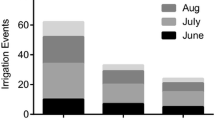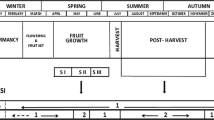Abstract
The use of plant indicators may be the ideal method for irrigation scheduling but it is hampered by the dynamic nature of plant water status and by the lack of suitable indicators, relative to established scheduling methods based on atmospheric and soil observations. A study was conducted in an almond orchard located in the San Joaquin Valley of California during the 2001 season using trunk diameter variations as the only indicator for determining the amount of irrigation. The ratio of the maximum daily shrinkage (MDS) of tree trunks relative to a reference MDS, calculated from a relationship between MDS of fully irrigated trees and atmospheric vapor pressure deficit, was used as a signal for modifying the amount of applied irrigation water. Applied water was increased by 10% each time the MDS signal exceeded the prescribed threshold. When the MDS signal went below the threshold, applied water was reduced by 10% in an interactive manner. Two schedules were tested with signal thresholds of 1.75 and 2.75, which generated mild and moderate water stress, respectively, as indicated by their stem water potential (SWP) values. The two irrigation treatments had SWP that varied over the season from around −0.7 to −1.1 MPa and −0.8 to −1.7 MPa, respectively. The two schedules resulted in seasonal water applications of 860 mm for the 1.75 and 525 mm for the 2.75 signal threshold treatments. The grower/cooperator, who based his schedule primarily on SWP measurements but also considered the water balance, applied 900 mm. Estimated crop evapotranspiration was 1,030 mm. The mean coefficients of variation for the two irrigation treatments during the monitoring period were 0.115 and 0.031 for the MDS and SWP measurements, respectively. The stress produced by the irrigation treatments hastened fruit maturation, as evidenced by accelerated hull splitting. This resulted in lower fruit hydration just prior to harvest; 17.3% and 8.0% for the two irrigation schedules, respectively, compared with 27.3% for the grower/cooperator. Based on harvesting selected trees with the same nut load, fresh and dry nut weights in the 2.75 threshold treatment were 9.0% and 10.7% less than those of the 1.75 threshold, which were not significantly different from the results for the grower cooperator. Our results demonstrate that it is feasible to develop an irrigation schedule for almond trees based solely on MDS signals, which may be tailored to any desired stress pattern and be operated in full automation with appropriate software development.




Similar content being viewed by others
References
Allen RG, Pereira LS, Raes D, Smith M (1998) Crop evapotranspiration: guidelines for computing crop water requirements. (Irrigation and drainage paper no. 56) FAO, Rome
Caspari HW, Behboudian MH, Chalmers DJ (1994) Water use, growth, and fruit yield of Hosui Asian pears under deficit irrigation. J Am Soc Hortic Sci 119(N3):383–388
Cohen Y, Fuchs M, Green GC (1981) Improvement of the heat pulse method for measuring sap flow in the stems of trees and herbaceous plants. Agronomie 9:321–325
Eastham J, Gray SA (1998) A preliminary evaluation of the suitability of sap flow sensors for use in scheduling vineyard irrigation. Am J Enol Vitic 49(2):171–176
Esparza G, DeJong TM, Weinbaum SA, Klein I (2001) Effects of irrigation deprivation during the harvest period on yield determinants in almond trees. Tree Physiol 21:1073–1079
Fereres E, Goldhamer DA (1990) Irrigation of deciduous fruit and nut trees. In: Stewart BA, Nielsen DR (eds) Irrigation of agricultural crops. (ASA monograph no. 30) American Society of Agronomy, Madison, Wis., pp 987–1017
Fereres E, Goldhamer DA (2003) Suitability of stem diameter variations and water potential as indicators for irrigation scheduling of almond trees. J Hortic Sci Biotechnol 78:139–144
Ginestar C, Castel JR (1996) Utilizacion de dendrometros como indicadores de estrés hidrico en mandarinos jovenes regados por goteo. Riegos y Drenajes XXI 89:40–46
Goldhamer DA (1989) Drought irrigation strategies for deciduous orchards. (Publication no. 21453) University of California Division of Agricultural and Natural Resources, Calif.
Goldhamer DA, Fereres E (2001a) Simplified tree water status measurements can aid almond irrigation. Calif Agric 55(3):32–37
Goldhamer DA, Fereres E (2001b) Irrigation scheduling protocols using continuously recorded trunk diameter measurements. Irrig Sci 20:115–125
Goldhamer DA, Smith T (1995) Single season drought irrigation strategies influence almond production. Calif Agric 49(1):19–22
Goldhamer DA, Viveros M (2000) Effects of preharvest irrigation cutoff durations and postharvest water deprivation on almond tree performance. Irrig Sci 19:125–131
Goldhamer DA, Fereres E, Mata M, Girona J, Cohen M (1999a) Sensitivity of continuous and discrete plant and soil water stress monitoring in peach trees subjected to deficit irrigation. J Am Soc Hortic Sci 124(4):437–444
Goldhamer DA, Fereres E, Cohen M, Girona J, Mata M (1999b) Comparison of continuous and discrete plant-based monitoring for detecting tree water deficits and barriers to grower adoption for irrigation management. Acta Hortic 537:431–445
Goodwin I, Jerie P (1992) Regulated deficit irrigation: from concept to practice. Aust NZ Wine Ind J (Advances in vineyard irrigation) 10 July 1992:258–261
Howell TA (2001) Enhancing water use efficiency in irrigated agriculture. Agron J 93:281–289
Hsiao TC (1990) Measurements of plant water status. In: Stewart BA, Nielsen DR (eds) Irrigation of agricultural crops. (ASA monograph 30) American Society of Agronomy, Madison, Wis., pp 243–279
Klepper B, Browning VD, Taylor HM (1971) Stem diameter in relation to plant water status. Plant Physiol 48:683–685
Lampinen BD, Shackel KA, Southwick SM, Olson B, Yeager JT, Goldhamer D (1995) Sensitivity of yield and quality of French prune to water deprivation at different fruit growth stages. J Am Soc Hortic Sci 120(2):139–147
Leib BG, Hattendorf M, Elliot T, Matthews G (2002) Adoption and adaptation of scientific irrigation scheduling: trends from Washington, USA as of 1998. Agric Water Manage 55:105–120
Li SH, Huguet JG, Bussi C (1989) Irrigation scheduling in mature peach orchard using tensiometers and dendrometers. Irrig Drain Syst 3:1–12
Link SO, Thiede ME, Bavel MG van (1998) An improved strain-gauge device for continuous field measurement of stem and fruit diameter. J Exp Bot 49:1583–1587
Mitchell PD, Chalmers DJ, Jerie PH, Burge G (1986) The use of initial withholding of irrigation and tree spacing to enhance the effect of regulated deficit irrigation on pear trees. J Am Soc Hortic Sci 111(6):858–861
Mitchell PD, Ende B van den, Jerie PH, Chalmers DJ (1989) Responses of ‘Barlett’ pear to withholding irrigation, regulated deficit irrigation, and tree spacing. J Am Soc Hortic Sci 114(1):15–19
Molden DJ, Sakthivadivel R, Perry CJ, Fraitture C de, Kloezen WH (1998) Indicators for comparing performance of irrigated agricultural systems. (Research report 20) International Water Management Institute, Colombo, Sri Lanka
Seckler D (1996) The new era of water resources management: from ‘dry’ to ‘wet’ water savings. (Research report 1) International Irrigation Management Institute (IWMI), Colombo, Sri Lanka
Shackel KA, Ahmadi H, Biasi W, Buchner R, Goldhamer D, Gurusinghe S, Hasey J, Kester D, Krueger B, Lampinen B, McGourty G, Micke W, Mitcham E, Olson B, Pelletrau K, Philips H, Ramos D, Schwankl L, Sibbett S, Snyder R, Southwick S, Stevenson M, Thorpe M, Weinbaum S, Yeager J (1997) Plant water status as an index of irrigation need in deciduous fruit trees. HortTechnology 7(1):23–29
State of California Department of Water Resources (1998) The California Water Plan Update. (Bulletin 160–98, vol. 1) Sacramento, Calif.
Teviotdale BL, Goldhamer DA, Viveros M (2001) Effects of deficit irrigation on hull rot disease of almond trees caused by Monilinia fructicola and Rhizopus stolonifer. Plant Dis 85(4):399–403
Ueda M, Shibata E (2001) Diurnal changes in branch diameter as indicator of water status of hinoki cypress Chamaecyparis obtusa. Trees 15:315–318
Zalom FG, Bentley WJ (1985) Southern fire ant (Hymenoptera: Formicidae) damage to harvested almonds in California. J Econ Entomol 78(2):339–341
Acknowledgements
We sincerely appreciate the assistance of Mario Salinas, who made the irrigation scheduling recommendations based on the MDS values, and Jesus Salinas and Miguel Marquez, who collected data. We also gratefully acknowledge the assistance of Joe Gonzales, irrigation supervisor at Paramount Farming, who implemented the constantly altering applied water rates. Thanks also are expressed to the Paramount management and other staff, including Joe McIlvaine, Dennis Elam, Paulin Garcia, and Aniceto Mejia.
Author information
Authors and Affiliations
Corresponding author
Additional information
Communicated by R. Evans
Rights and permissions
About this article
Cite this article
Goldhamer, D.A., Fereres, E. Irrigation scheduling of almond trees with trunk diameter sensors. Irrig Sci 23, 11–19 (2004). https://doi.org/10.1007/s00271-003-0088-0
Received:
Accepted:
Published:
Issue Date:
DOI: https://doi.org/10.1007/s00271-003-0088-0




